
International Research Journal of Engineering and Technology (IRJET) e-ISSN:2395-0056
Volume: 11 Issue: 08 | Aug 2024 www.irjet.net p-ISSN:2395-0072


International Research Journal of Engineering and Technology (IRJET) e-ISSN:2395-0056
Volume: 11 Issue: 08 | Aug 2024 www.irjet.net p-ISSN:2395-0072
Shiv Chauhan1, Karanpreet Singh2, Utkarsh Tripathi3, Navkaran Singh4, Chetan Sharma5
1Third Year UG Student, UIE, Chandigarh University, Punjab, India
2Third Year UG Student, UIE, Chandigarh University, Punjab, India
3Third Year UG Student, UIE, Chandigarh University, Punjab, India
4Third Year UG Student, UIE, Chandigarh University, Punjab, India
5Third Year UG Student, UIE, Chandigarh University, Punjab, India
Abstract - This research paper reviews a comprehensive Gitness website aiming to support users in achieving their Gitness goals and sustaining a healthy lifestyle. The website offers features such as educational Gitness blogs, an interactive Gitness chatbot, and customised nutrition plans. Through an extensive literature review on AI chatbots in healthcare and Gitness, common limitations are identiGied, leading to the proposal of a novel solution a website built using HTML, CSS, and JavaScript. The proposed website addresses existing shortcomings by providing tailored nutrition plans, interactive chatbot support, informative workout blogs, and user feedback mechanisms. Future scope includes personalised training plans, live consultations with Gitness experts, multilingual support, and integration with voice assistants. By leveraging these strategies, the project aims to empower users to achieve their Gitness goals effectively while positioning itself as a leading resource in the Gitness and health industry.
Key Words: $itness website, digital platforms, chatbot, virtual $itness support, machine learning, AI health applications.
The way that technology is incorporated into different aspects of daily life has changed the landscape of $itness andhealthinrecentyears.Peopletodayhaveunparalleled access to tools and support networks that help them in their quest for a better lifestyle thanks to the growth of digital platforms. Creating extensive $itness websites that act as virtual hubs for people looking for advice, inspiration, and information on their $itness journeys is onewaythatthistrendismanifestingitself.
This essay reviews a $itness website's features and design intending to provide customers with a comprehensive approach to wellness. The website consists of three main components: a library of educational $itness blogs, an interactive$itnesschatbot,andcustomizednutritionplans. The website hopes to give users a comprehensive arsenal to support their $itness objectives and encourage a sustainedlifestyleshiftbyintegratingthesecomponents.
The customized nutrition plans that are available on the internet are centered around the needs and objectives of each user. These programs offer calorie tracking, nutritionalcounseling,andpersonalizedmealchoicesbased on user input and algorithms. Through addressing this important topic of nutrition, the website hopes to provide visitors with the information and tools they need to continue eating a balanced diet that supports their$itness goals. These nutrition plans are made to beinclusive and successful for a wide range of users by accommodating differentdietarypreferencesandlimits.
The website offers individualized workout suggestions and nutritionregimens,aswellasaninteractive$itnesschatbot that engages users in real-time chats. With the use of machine learning and natural language processing, the chatbot provides personalized training plans, exercise demos, and encouragement. The chatbot is designed to mimic the experience of working with a personal trainer by providing users with assistance and encouragement at their convenience using a conversational interface. This interactive feature improves accessibility and user engagement by offering a dynamic platform where people cangetindividualized$itnessadviceandsupportwhenever andwherevertheychoose.
ThestudybyJuananPereiraetal.emphasizessuccesseslike figuring out which major health domains chatbots target andstressingthevalueofhumancompetencieslikeeffect.It does, however, highlight certain shortcomings,such as the requirement for improved case-study reportingprocedures and a more thorough examination of the sociological ramificationsofchatbotuseinthehealthcareindustry.
The document created by Nirmalie Wiratunga et al. highlights achievements like the creation of "Fit-Chat," an artificial intelligence chatbot that uses speech recognition to promote physical activity among senior citizens via cocreation workshops and Think Aloud sessions. Positive commentsabouthoweffectivethechatbotisarealsomade public. Limitations that raise concerns about

International Research Journal of Engineering and Technology (IRJET) e-ISSN:2395-0056
Volume: 11 Issue: 08 | Aug 2024 www.irjet.net p-ISSN:2395-0072
representativeness and potential challenges in implementing voice-based conversational treatments for behaviorchangeincludethe lack ofparticipantdetails,the diversity of participant demographics, and the discussion oflong-termefficacy.
The study by Amanda L. Zaleski et al. lists the advantages and disa dva nt ages of AI-generat ed exe rc ise recommendations. Although it lacks crucial components like frequency and intensity, it shows a high degree of accuracy and moderate comprehensiveness when compared to gold-standard guidelines. Moreover, the content's college-level complexity makes it difficult for thosewithlowhealthliteracytoaccess,whichmayworsen healthcare disparities. Continuous evaluation is necessary to address recommendation biases and discrimination, emphasizing the need for healthcare practitioners to be supervisedandtorelywithcaution.
The work by Sai Rugved Lola et al. describes a chatbot for fitnessmanagementthatispoweredbyIBMWatson,witha focus on features like personalized and proactive support. It discusses the issues facing the fitness sector as well as the technical difficultiesin implementingchatbots,such as intent classification and algorithmic processes. It does, however,fallshortinitsanalysisoftheuserexperienceand ethical implications, which leaves room for more investigation in follow-up studies on the effects of chatbot technology.
In a study that looked at the effectiveness of a machine learning-based physical activity chatbot in motivating peopletobemoreactive,QuengGToetal.didanexcellent jobdemonstratingsignificantincreasesindailystepcounts and overall physical activity. But due to technical issues brought on by a modification in Facebook policy, the chatbot's functionality was limited, underscoring the need for substitute platforms. Notwithstanding the promising results of the study, limitations like a non-representative sample and the absence of a control group highlight the needforadditionalresearchtoconfirmefficacyandexplore widerpopulationapplicability.
According to research by Dillys Larbi et al., Norwegians would prefer it if a chatbot was integrated with activity monitors on social media platforms in order to promote physical activity. It highlights the level of interest users have in things like weekly step targets and daily communication. The research has certain limitations, though, including its narrow focus on Norwegian adults andpotentialbiasesresultingfromusinganonlinesurvey. Nonetheless,ithighlightshowimportantuserparticipation istodevelopingeffectivedigitalhealthinterventions.
Coach-AI is a text-based chatbot that assists doctors in treating patients and supports health coaches. Ahmed Fadhil presented a report outlining the chatbot's accomplishments. It effectively addresses the need to
reduce medical staff workloads while providing patients with 24-hour care by emphasizing the platform's ability to track patient conditions, provide insights, and recommend the best course of action. However, there are a number of shortcomings, including the preliminary nature of the evaluation and the need for further validation through extensive testing with real customers. Still, it does show howchatbotscouldimprovehealthcarepreventionandhelp physicianstreatpatientswithexcellence.
In Daniele Giansanti's paper, chatbots in the healthcare sector are thoroughly examined, with a focus on their creation, applications, and outcomes. The analysis of chatbots' historical development and their various applications in healthcare, including telemedicine and patientsupport,isdonequitewell.Amongitsshortcomings are the potential biases in the systematic review analysis and the lack of a comprehensive investigation of specific chatbot implementations. Nonetheless, it underscores the significanceofinterdisciplinaryteamscollaboratingandthe responsible application of chatbot technology in the healthcaresector.
A scoping study by Xue et al. assesses chatbots related to health in detail in order to enhance their design and promote changes in behavior and health. It locates and evaluates 36 chatbots with success, revealing a variety of characteristics and communication philosophies. However, thereareanumberofnegatives,includingalackofuniform assessment criteria and erratic user sentiment in in-app ratings. Nonetheless, the research highlights the significance of user-centered design and comprehensive testing in maximizing the potential of chatbots to promote health.
The paper "Perceptions and Opinions of Patients About Mental Health Chatbots: Scoping Review" by Alaa A. AbdAlrazaqetal.offersacomprehensiveassessmentofpatients' opinions and views on these chatbots. Scoping review conducted in accordance with PRISMA guidelines yielded ten major topics through the application of theme analysis. Overall, patients had positive things to say about the usability, acceptability, and ease of use of chatbots for mental health. In order to improve chatbots' effectiveness and acceptance in the treatment of mental health issues, more research is required to tackle important issues like languagecompetencyanduserinputresponsiveness.
The scoping review by Roupeng An et al. assesses the efficacyofAItechniquesinphysicalactivity(PA)treatments by demonstrating their ability to predict outcomes and identify patterns in PA behavior. AI models outperform traditional statistical methods, and the use of DL and RL is growing. Two of the six primary areas where AI in PA treatmentsisanticipatedtobeimplementedinthefutureare personalized recommendations and injury prevention. The review demonstrates how different AI applications in PA

International Research Journal of Engineering and Technology (IRJET) e-ISSN:2395-0056
Volume: 11 Issue: 08 | Aug 2024 www.irjet.net p-ISSN:2395-0072
interventions have the potential to change interventions andenhancewell-beingthroughclassification.
Thepotentialofchatbotsasacutting-edgeuserinterfacefor youth health information is discussed by MaritaBjaaland Skjuveetal.Ithighlightshowtrustworthy,confidential,and anonymous mental health care can be obtained through chatbots. However, it also discusses disadvantages such as issues with technology, ethical quandaries,andtheneedfor consistentuserparticipation.
The work of Nivedita Bhirud et al. provides a comprehensiveanalysisofchatbotsinthehealthcaresector, emphasizing the potential benefits of machine learning (ML), natural language generation (NLG), and natural language understanding (NLU) for enhancing communication. Among the achievements are in-depth understandings of NLU, NLG, and machine learning algorithms. Nevertheless, the paper lacks examples of real- world implementation. Furthermore, there's not much talk about the ethical ramifications of using chatbots in medicalsettings.
ThestudybyMladenJovanovicetal.discussestheincreasing role chatbots are playing in the provision of healthcare services, focusing on features and aspects ofdesign that are relevant to their application. Not only have conversational style analysis, user comprehension, accountability, and healthcare supply been identified, but also diagnosis, prevention, and therapy archetypes have been identified. Some of the constraints include the lack of social and emotionalintelligence,theopaquenessofdatacollection,and theneedforimprovederrorrecoverymethods.
The HOLMeS system, which uses chatbots for eHealth applications, is covered by Flora Amato et al. Achievements include evaluating illness preventive pathways through machine learning and leveraging chatbots to mimic human interaction for medical suggestions. The necessity for more advancements in human-like behaviors and interaction paradigmsisoneofthelimitations.Overall, HOLMeShas the potential to automate healthcare, but it still has to be improvedforthebestpossibleuserexperience.
The paper by Lea Reis et al. highlights 14 application scenarios for chatbots in healthcare and discusses their implementation from the perspectives of physicians and patients. It adds by fusing the two points of view, offering novel concepts, and highlighting challenges and barriers particulartothefield.Yet,thestudymakesnomentionofthe technical difficulties associated with deploying chatbots in medicalenvironments.
Kowatschetal.presentastudythatsupportstheuseof textbased healthcare chatbots (THCB) as an intervention for paediatric obesity.Positive subjective enjoyment, strong attachment bonds, high intervention adherence, and scalability are examples of successes. Additional
comparisons with control groups and medical outcome assessment arenecessary, which isone ofthelimitations. .The scoping review by Abd-Alrazaq et al. provides a comprehensive overview of chatbots usedin mental health, identifying41differentchatbotsandtheir salient features. It highlightsthepromiseofchatbotsforscreening,training,and rehabilitation while bringing attention to the fact that research in this field isstill in its early stages. The lack of studies that arerandomized controlled and the anomalies in Theshortcomings include, however, outcome measures andreporting. Reporting criteria and standardizing metrics shouldbethemaintopicsoffutureresearch.
AstudybyJahanviGuptaetal.discussesthedevelopmentof Florence, a health chatbot that makes use of the RASA framework to offer nutritional breakdowns and predict illnessesbasedonusersymptoms.Amongthesuccesses are precise food analyses and sickness forecasting. However, limitationsmayincludetheneedforongoingadjustmentsto incorporate new conditions and symptoms as well as potential challenges with accurately diagnosing complex or rareconditions.
In the Holmes W. et al. study, the usability of the WeightMentor healthcare chatbot was assessed using traditional usability criteria. Achievements include strong questionnaire correlations, high usability scores, and quick user competency. The study suggests that additional participants are needed to identify usability issues, raising doubts about the applicability of conventional usability measurements for chatbots. The study also highlights the potential limitations of using traditional usability tests for chatbots.
The article by Joshua Au Yeung et al. compares the capabilitiesofChatGPTandForesightmodelstoexplorethe possibleapplicationsoflargelanguagemodels(LLMs)inthe healthcareindustry.ItdrawsattentiontothesuccessesLLMs have had in responding to medical questions, but it also draws attention to some of their drawbacks, including associations,biases,andthepossibilityofproducingoutputs that are dishonest or factually inaccurate. The study emphasizes how domain-specific training data and professional doctors' fine-tuning are essential for ensuring the safe and responsible deployment of AI chatbots in the healthcareindustry.
The construction of a theory on trust in health chatbots through a qualitative method is covered in the work by Weiyu Wang et al. It pinpoints elements like perceived performance and privacy problems that have an impact on trust. For interviews, Keeney's Value-Focused Thinking methodisemployed.Thestudyintendstoaddtothebodyof knowledge on AI trust as well as offer practical insights for practitioners.Amongthelimitationsarethedearthofactual dataandtherequirementforadditionalvalidation.

International Research Journal of Engineering and Technology (IRJET) e-ISSN:2395-0056
Volume: 11 Issue: 08 | Aug 2024 www.irjet.net p-ISSN:2395-0072
The article by Soufyane Ayanouz et al. addresses the use of NLPandmachinelearningtocreateintelligentchatbot
architectureforhealthcaresupport.Itdrawsattentionto the advancementsmadeinchatbotdevelopmentbycutting-edge AItechnology,likeenhancednaturallanguagegenerationand understanding. It also lists several drawbacks, such as responses that must adhere to strict rules, grammatical mistakes, and difficulties interpreting subtleties in natural language.
An overview of chatbot creation and integration technologies, such as AIML, ChatScript, heuristic techniques,andonlineplatforms,isgiveninthedocumentby Aarash Trivedi et al. It emphasizes how chatbots may improve customer service and advance business. It is deficient in real-world implementation examples and comprehensive technical information, nevertheless. The significance of integrating chatbots through third-party services, manual integration, or APIs is emphasized in the study.
Atechniqueforcreatingchatbotsautomaticallyfromwebsite content is presented in the study by Pietro Chitto et al., allowing for conversational web browsing. It presents a prototype implementation, an annotation format, and a conceptual vocabulary. While there have been advancements in enabling chatbot generation from web pages,therearestilldrawbacks,suchastherequirement for manualannotationsandpage-by-pagetraining.
The application of chatbots in home automation, health, and public administration is examined in the paper by Stefano Valtolina et al. It draws attention to the benefits of chatbots, includingtheiraffordability, personalization,andease of use. It also discusses challenges, such as the requirement for enhanced artificial intelligence and user reluctance. The studyshowshowachatbotforpublicadministrationmaybe successfully implemented and how this can improve user experience.
The essay by Darius Zumstien and colleagues discusses the introductionof chatbots andtheir benefits, drawbacks, and technological functionality. A presentation of research on theuseofchatbots inpublic transportation emphasizes the potential for personalized services and positive customer feedback. It also highlights shortcomings, such as concerns aboutdataprivacy anduser adaptability. Thereportmakes recommendations for fresh chances to engage in crosssellinginpublictransportation.
Wewereabletoidentifytheissuesthatweresharedbythe numerous solutions that have been put forth up to this pointbyexaminingthenumerousinformationsourcesand literature. In an attempt to address every potential objective and create the perfect project with all the necessaryfeatures, wehave putfortha designinan effort toaddresstheissueswehaveencounteredthusfar.
We have proposed a website using HTML, CSS, and Javascript that offers a comprehensive solution to the given problem statement. Among its many functionalities are diet plans, exercise blogs, user chatbot support, and more.
Now we will be discussing the various functionalities we havebuiltintoourproject
Basic overview of the projectHome Section:
Since it receives the most views and encourages user interaction, the home section of a website is the most important part of the whole thing. We have constructed a number of sections for the home page, including a navigation bar, hero section, about section, blogs about exercise, nutrition plans, integrated chatbot, and contacts sectionattheend.

Our website satis$ies the current requirements for websites, such as responsiveness. Because it adapts its structuretothedevicebeingusedtoviewit,thewebsiteis extremelyresponsive.
About Section:
This part offers some fundamental details about the company, as the name would imply. Also included in this sectionarethetrainers’informationcards.
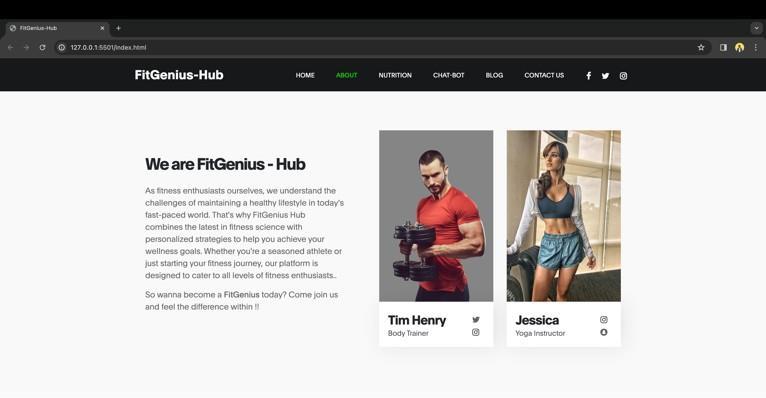

International Research Journal of Engineering and Technology (IRJET)
Volume: 11 Issue: 08 | Aug 2024 www.irjet.net
Nutrition Plans Section:
The nutrition plans section comes after the About section. The trainees' diet plans are the focus of this section. The menu is divided into three sections: custom diet, nonvegan,andvegan.Inordertocreateapersonalizeddietplan that meets their needs, users must utilize the chatbot featureofthecustomdiet.
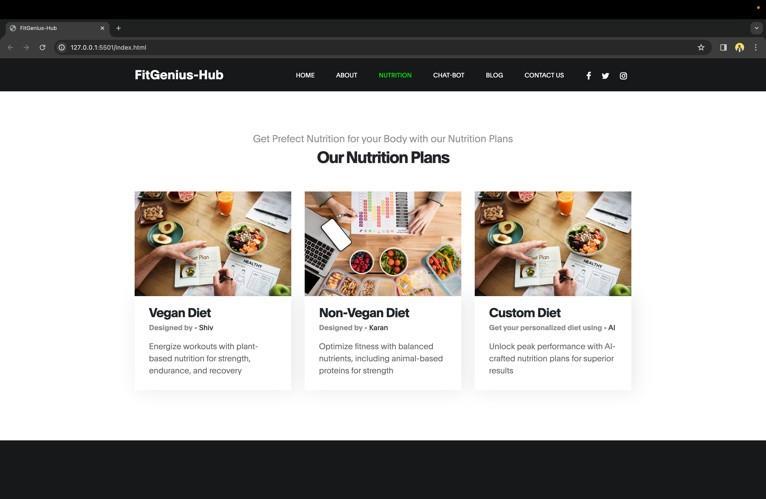
Chatbot Section:
Despite being brief, this section of the project is crucial. This section will include the prompt line that users will needtointeractwith“Gym-Genius,"ourchatbot.Userscan use GymGenius to retrieve additional workout-related information,andtheycanusethischatbottoaskquestions aboutdietandexerciseplans.

Blogs Section:
A blog section will follow the chatbot section. A few blogs about workouts and associated subjects about the gym andtheworkoutlifestylewouldbeincluded.
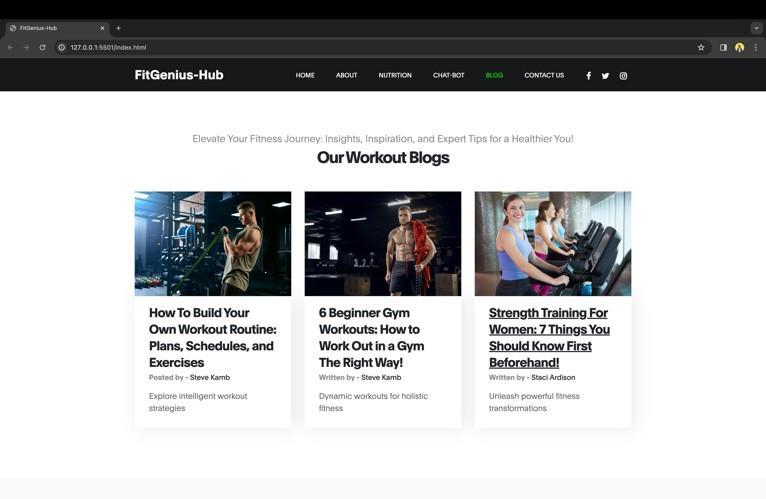
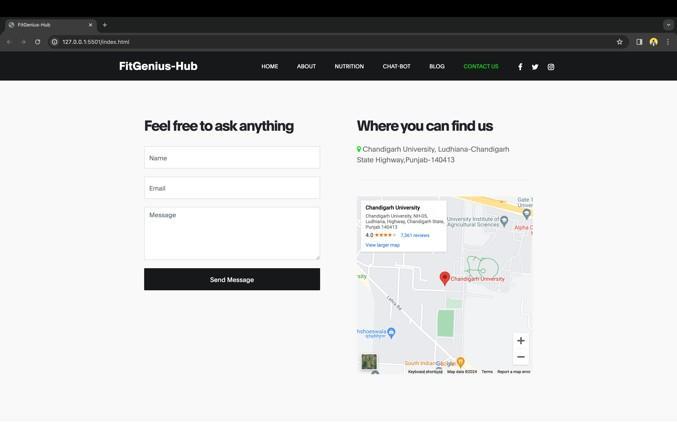
Key features of the project
Feedback Section:
As the name suggests, this section is going to contain the elements related to user feedback. Since user feedback is very essential in these kinds of websites, we have added a form to fetch the user feedback and queries also. This section also contains a mini-map for the location of the of$linegym.
Nutrition Section
This is one of the important sections of the website as the trainees who are following proper workout plans are somewhere confused about the diet plans. This section wouldcontainthreedifferentcardsnamelythevegandiet, nonvegandiet,andthecustomdiet.
After choosing the vegan diet option, the user will be redirected to a different page where they can learn the fundamentals of the vegan diet and its ingredients. Apart from this, three pre-made diet plans are available, each withtherightfoodsforspeci$ictimesoftheday.Allofthe

International Research Journal of Engineering and Technology (IRJET) e-ISSN:2395-0056
Volume: 11 Issue: 08 | Aug 2024 www.irjet.net
food items are arranged inside cards that list the ingredients along with how much nutrition each will providetheuserwhenconsumed.
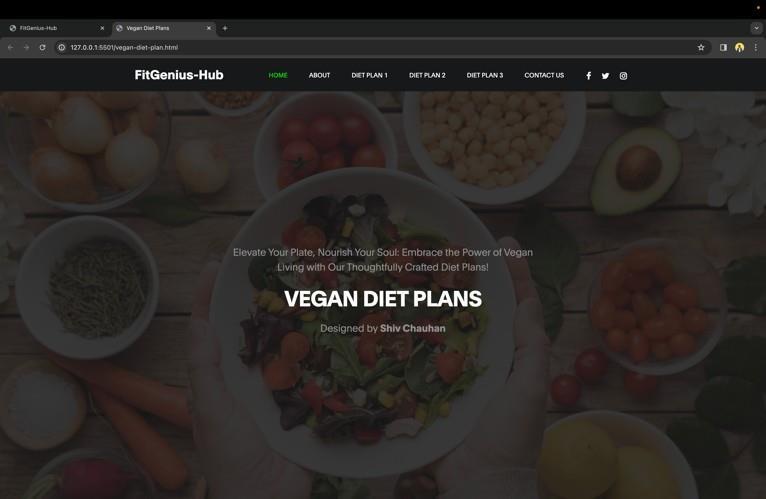
Theuserwouldbetakentoadifferentpage,justlikeinthe previous instance, if they clicked on the non-vegan diet option. Three pre-made diet plans would be listed on the page after some general information about the non-vegan diet. This page operates in the same exact manner as the precedingone.
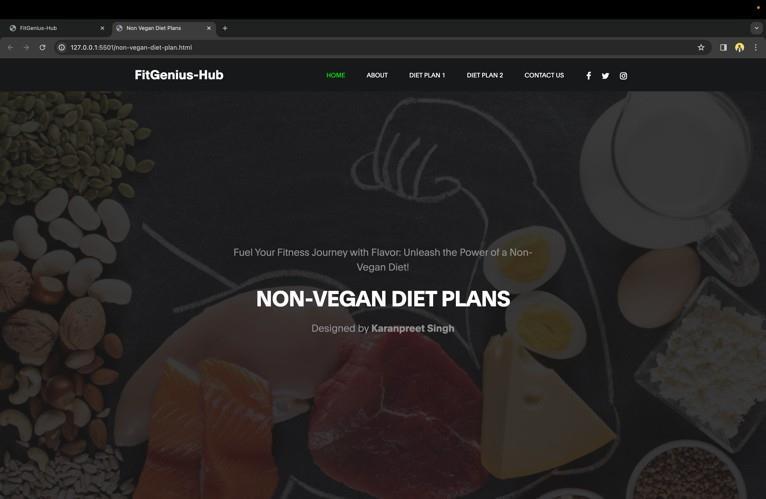
Onclickingthecustomdietoption,theuserwillbeableto access the chatbot GymGenius to fetch the diet plan based ontheuser’spromptsanddemandsforthedietplan.
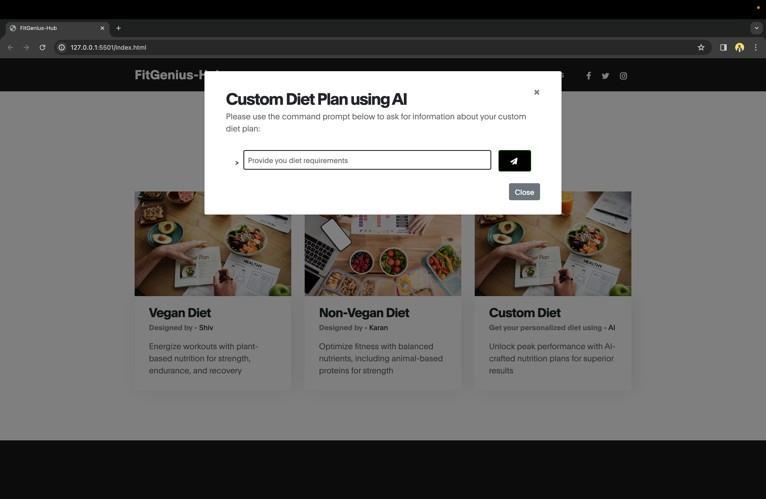
Thisisgoingtobeanotherimportantfeatureof ourproject as it is the core key feature of our website. The chatbot wouldbethemainpointofuserengagementonthewebsite asthechatbotsareamongthemostdemandedtechnologies across the globe nowadays. The users can askthe chatbot aboutvariousqueriesrelatedto$itness,workoutplans,diet plans,andotherqueriesrelatedtophysicalhealth.

Blogs Section
This section is going to contain blogs related to workouts and related topics. This is going to be important for those trainees who like to read about the current scenarios in the workout $ield. There would be 3 cards present in the section clicking upon which the user would be redirected totheblog.


International Research Journal of Engineering and Technology (IRJET) e-ISSN:2395-0056
Volume: 11 Issue: 08 | Aug 2024 www.irjet.net p-ISSN:2395-0072
The different objectives listed in the project's problem statement will all be accomplished with the help of this project.
Ultimately,wehavecreatedathoroughwebsitefor$itness enthusiasts, addressing the most prevalent drawbacks of the solutions that are currently in place. Our website, which was created with HTML, CSS, and Javascript, has many features, including pre-made meal plans, $itness blogs, an interactive chat room called "GymGenius," and ways for users to leave feedback. This mobile-friendly websiteoffersfeatureslikeasectiondedicatedtotrainers, chat-based customized nutrition plans, and educational blogs. We are con$ident that this project will successfully address the issues raised in the problem statement and openthedoorforfurtherdevelopmentsintailored$itness regimens.
Envision customized workout regimens with activity trackersthatarebasedonyourindividualobjectives,level of $itness, and advancement. This makes everyone's training experience more engaging and fruitful. Through forums and social media, we hope to create a welcoming environment where users can engage, exchange stories, andinspireoneanothertoachievesuccess.
To improve the experience, we intend to incorporate cutting-edge technology. Real-time coaching and support can be obtained through live chat and video consultations with nutritionists and coaches. In order to keep users interested and inspired, we also investigate gameplay and progress tracking. Partnerships with $itness brands also offer easy shopping experiences that make your journey towardbetterhealthmoreconvenient.
Expanding one's audience is a top priority. We want to reach a wider audience by providing a website that is available in several languages. The mobile application is designed to be $lexible and used while on the go. In addition,theintegrationofthevoiceassistantisconsidered tofurtherimprovetheuserexperience.
Personalization requires the use of arti$icial intelligence and data. In order to tailor the user experience, wegather and examine user data. We also monitor activity, preferences, and feedback in order to make the website better and deliver pertinent content. Integration with mobile devices offers users a more thorough understanding of their progress and allows for comprehensive data tracking. Furthermore, AI is utilized to provide tailored training regimens and content recommendations so that every user can maximize their $itnessjourney.
Growth that is sustainable is necessary for long-term effects.Wearelookingintowaystomakemoney,likeaddon features, subscriptions, and joint ventures with $itness companies. Focusing on particular $itness objectives and demographics enables us to draw in a larger user base. Ultimately, by creating ef$icient marketing plans, we are able to connect with our target market, boost website traf$ic,andestablishourauthorityinthe$itnessandhealth sector.
By leaning on these areas, we believe that we can continuously improve and improve our project to empower people to achieve their $itness goals in a personalized,engaging,andeffectiveway.
1. ereira a Ok. (2019). Using health chatbots for behavior change: a mapping study. Journal of medical systems,43,1-13.
2. Wiratunga, N., Cooper, K., Wijekoon, A., Palihawadana, C.,Mendham,V.,Reiter,E.,&Martin,K.(2020).FitChat: conversational arti$icial intelligence interventions for encouraging physical activity in older adults. arXiv preprintarXiv:2004.14067.
3. Zaleski,A.L.,Berkowsky,R.,Craig,K.J.T.,&Pescatello, L. S. (2024). Comprehensiveness, Accuracy, and Readability of Exercise Recommendations Provided by an AI-Based Chatbot: Mixed Methods Study. JMIR MedicalEducation,10(1),e51308.
4. To, Q. G., Green, C., & Vandelanotte, C. (2021). Feasibility, Usability, and Effectiveness of a Machine Learning–Based Physical Activity Chatbot: QuasiExperimental Study. JMIR mHealth and uHealth, 9(11), e28577.
5. Larbi, D., Sandsdalen, H., Gabarron, E., Arrsand, E., & Henriksen, A. (2022). User preferences for a physical activity chatbot connected to an activity tracker and integratedintoasocialmediaplatform.
6. Fadhil, A. (2019). Text-based Chatbot Assisted Health Coaching System: Preliminary Evaluation & Results. University of Trento, Trento http://dx. doi. org/ 10.13140/RG,2(22231.32164).
7. Giansanti, D. (2023). The chatbots are invading us: a map point on the evolution, applications, opportunities, and emerging problems in the health domain.Life,13(5),1130.
8. Xue, J., Zhang, B., Zhao, Y., Zhang, Q., Zheng, C., Jiang, J., ... & Xiang, X. (2023). Evaluation of the Current State of Chatbots for Digital Health: Scoping Review. Journal ofMedicalInternetResearch,25,e47217.

International Research Journal of Engineering and Technology (IRJET) e-ISSN:2395-0056
Volume: 11 Issue: 08 | Aug 2024 www.irjet.net p-ISSN:2395-0072
9. Abd-Alrazaq,A.,etal.(2021).Patients'ViewsonMental HealthChatbots.JMedInternetRes,23(1),e17828.
10. An, R., Shen, J., Wang, J., & Yang, Y. (2023). A scoping review of methodologies for applying arti$icial intelligencetophysicalactivityinterventions.Journalof SportandHealthScience.
11. Skjuve,M.,&Brandtzæg,P.B.(2018).Chatbotsasanew userinterfaceforprovidinghealthinformationtoyoung people. Youth and news in a digital media environment–Nordic-Balticperspectives.
12. Bhirud,N.,Tataale,S.,Randive,S.,&Nahar,S.(2019).A literaturereviewonchatbotsinhealthcaredomain.Int JSciTechnolRes,8(7),225-231.
13. ovanovic ae asati hat otsas conversational healthcare services. IEEE Internet Computing,25(3),44-51.
14. Amato, F., Marrone, S., Moscato, V., Piantadosi, G., Picariello, A., & Sansone, C. (2017, November). Chatbots Meet eHealth: Automatizing Healthcare. In WAIAH@AI*IA(pp.40-49).
15. Reis, L., Maier, C., Mattke, J., & Weitzel, T. (2020). Chatbots in healthcare: Status quo, application scenarios for physicians and patients and future directions.
16. Kowatsch, T., Nißen, M., Shih, C. H. I., ue er D., Volland, D., Filler, A., ... & Farpour-Lambert, N. (2017). Text-basedhealthcarechatbotssupportingpatientand health professional teams: preliminary results of a randomized controlled trial on childhood obesity. Persuasive Embodied Agents for Behavior Change (PEACH2017).
17. Abd-Alrazaq,A.A.,Alajlani, M.,Alalwan,A.A.,Bewick, B.M.,Gardner,P.,&Househ,M.(2019).Anoverviewof the features of chatbots in mental health: A scoping review. International journal of medical informatics, 132,103978.
18. Gupta, J., Singh, V., & Kumar, I. (2021, March). Florence-a health care chatbot. In 2021 7th International Conference on AdvancedComputing and Communication Systems (ICACCS) (Vol. 1, pp. 504508).IEEE.
19. Holmes, S., Moorhead, A., Bond, R., Zheng, H., Coates, V.,&McTear,M.(2019,September).Usabilitytestingof a healthcare chatbot: Can we use conventional methods to assess conversational user interfaces?. In Proceedings of the 31st European Conference on CognitiveErgonomics(pp.207-214).
20. AuYeung,J.,Kraljevic,Z.,Luintel,A.,Balston,A.,Idowu, E.,Dobson,R.J.,&Teo,J.T.(2023).AIchatbotsnotyet ready for clinical use. Frontiers in digital health, 5, 1161098.
21. Wang, W., & Siau, K. (2018, December). Living with arti$icial intelligence–developing a theory on trust in health chatbots. In Proceedings of the sixteenth annualpre-ICISworkshoponHCIresearchinMIS(pp. 1-5). San Francisco, CA: Association for Information Systems.
22. Ayanouz, S., Abdelhakim, B. A., & Benhmed, M. (2020, March). A smart chatbot architecture based NLP and machine learning for health care assistance. In Proceedings of the 3rd international conference on networking,informationsystems&security(pp.1-6).
23. Trivedi, A., Gor, V., & Thakkar, Z. (2019). Chatbot generation and integration: A review. International JournalofAdvanceResearch,IdeasandInnovationsin Technology,5(2),1308-1311.
24. hitto ae anie enata ah Automatic generation of chatbots for conversational web browsing. In Conceptual Modeling: 39th International Conference, ER 2020, Vienna, Austria, November 3–6, 2020, Proceedings 39 (pp. 239-249). SpringerInternationalPublishing.
25. Di Gaetano, S., & Diliberto, P. (2018). Chatbots and conversational interfaces: Three domains of use. In Fifth International Workshop on Cultures of Participation in the Digital Age, Castiglione della Pescaia,Italy(Vol.2101,pp.62-70).
26. Zumstein, D., & Hundertmark, S. (2017). CHATBOTS AN INTERACTIVE TECHNOLOGY FOR PERSONALIZED COMMUNICATION, TRANSACTIONS AND SERVICES. IADISInternationalJournalonWWW/Internet,15(1).